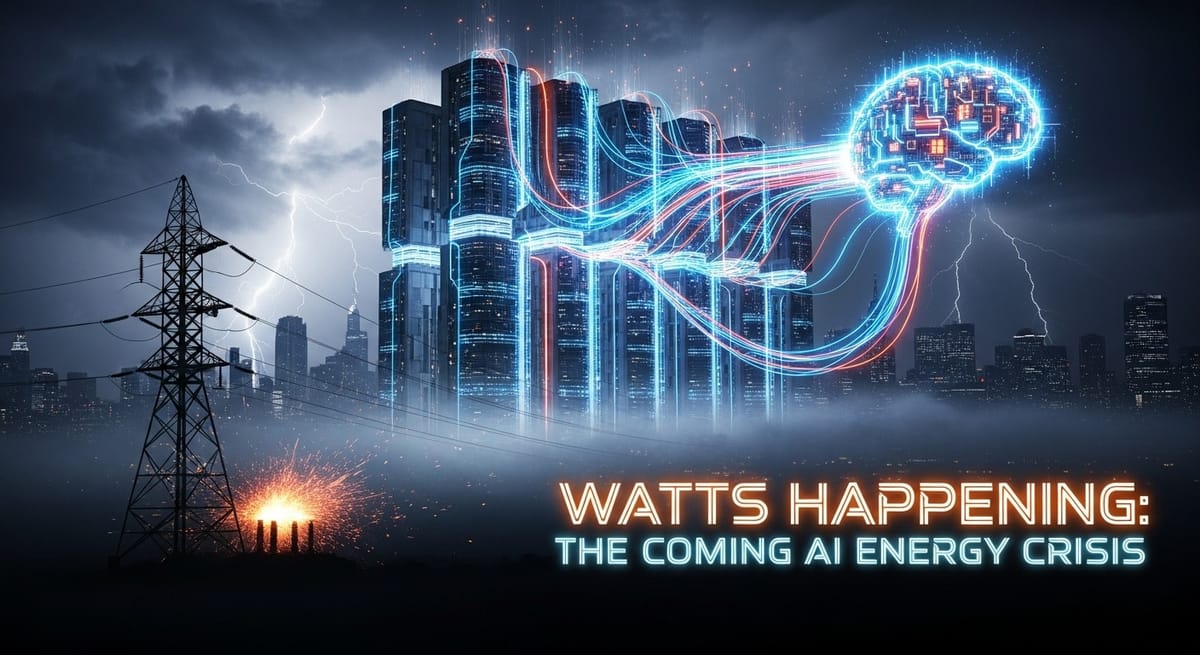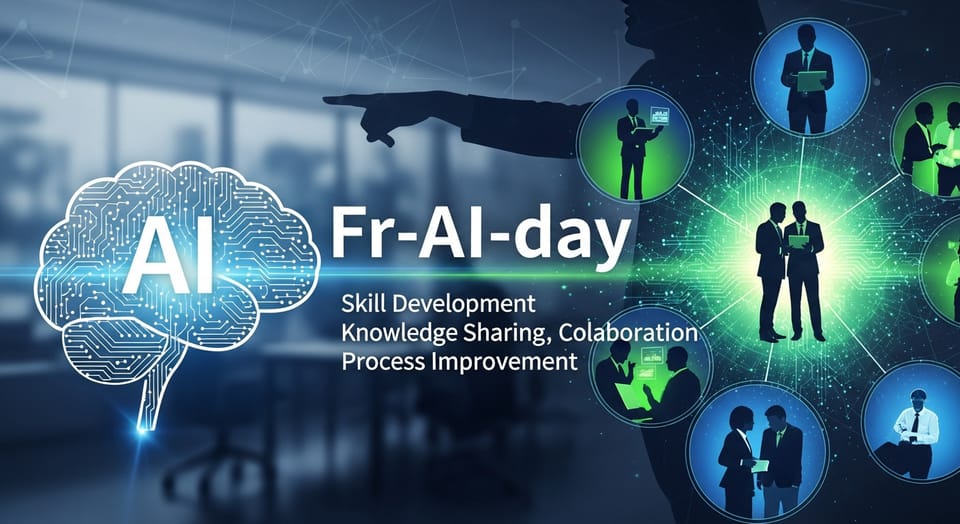Watts Happening: The Coming AI Energy Crisis

In a world increasingly defined by artificial intelligence breakthroughs, an overlooked challenge threatens to halt this technological revolution in its tracks: electricity. As AI systems grow more sophisticated and widespread, their voracious appetite for power has emerged as perhaps the most significant constraint on further development, creating a complex web of technical, economic, and environmental challenges.
The Staggering Energy Footprint
The energy demands of modern AI systems have reached alarming levels. Training a single large language model can consume as much electricity as 100 U.S. households use in an entire year. The carbon footprint of training GPT-3 alone was estimated at approximately 85 tons of CO2 equivalent—comparable to the lifetime emissions of five cars.
"The computational requirements for state-of-the-art AI models have been doubling approximately every 3.4 months since 2012, far outpacing Moore's Law," explains Dr. Emma Thompson, a computational sustainability researcher. "This exponential growth translates directly to increased energy consumption that our current infrastructure simply cannot sustain."
Data centers hosting AI services already consume 1-2% of global electricity, with projections suggesting this could reach 3-8% by 2030. This trajectory becomes even more concerning when considered alongside other growing electricity demands.
Competing With Other Electricity Demands
The AI power crunch doesn't exist in isolation. As one industry observer notes, "As we get more and more electric cars on the market, that may put an even larger burden on our grid." This convergence of increasing demands from multiple sectors—transportation, computing, and traditional uses—creates a perfect storm for electricity infrastructure.
The question becomes not just whether we can generate enough power, but how we prioritize its use across competing needs.
Infrastructure Reaching Its Limits
Current electrical infrastructure faces mounting pressure from AI-related demands:
- Geographic constraints limit high-capacity data centers to regions with abundant power resources
- Power density requirements for AI-optimized data centers exceed traditional IT workloads by 3-5 times
- Cooling systems for high-performance computing clusters consume up to 40% of the total energy used
- Grid stability concerns arise when large-scale AI training operations create variable load patterns
"We're not just talking about generating more electricity," says Carlos Ramirez, an energy systems analyst. "We're talking about completely reimagining our grid to handle these new types of loads."
The Economic Equation
The electricity constraint creates significant economic ripple effects that will reshape the AI industry:
- Energy costs may become the dominant factor in AI operation expenses, surpassing hardware costs
- Competitive advantage may shift to organizations with access to abundant, low-cost electricity
- Market concentration could increase as smaller players face prohibitive energy costs
- Energy efficiency may become a primary metric for evaluating AI systems, alongside accuracy and capability
Analysis from industry experts suggests that electricity costs already represent 30-40% of total operational expenses for large-scale AI deployments, a percentage likely to increase as models grow more complex.
Geopolitical Power Plays
Access to sufficient electrical power for AI development has important geopolitical implications. Countries with abundant, low-cost electricity resources may gain significant advantages in AI development.
"Energy independence becomes intertwined with technological sovereignty," explains Dr. Leila Khan, an international technology policy expert. "We're already seeing countries like Canada, Iceland, and Norway, with abundant hydroelectric power, positioning themselves as ideal locations for AI development."
This dynamic creates new international tensions over energy resources specifically for computing applications, with potential regulatory frameworks emerging to govern energy allocation for AI systems.
Environmental Sustainability at Stake
The environmental impact of AI's electricity consumption raises critical sustainability questions:
- Carbon emissions from electricity generation could offset efficiency gains in other sectors enabled by AI
- Water usage for cooling systems presents another environmental constraint
- E-waste from rapidly obsolete AI hardware creates additional environmental challenges
- Lifecycle assessment of AI systems needs to account for full energy and resource requirements
Recent research suggests that without significant intervention, AI-related carbon emissions could reach 3-5% of global emissions by 2030, comparable to the aviation industry.
Potential Solutions Emerging
Despite these challenges, promising solutions are beginning to emerge:
Nuclear Renaissance
"This can be solved with nuclear power as we are seeing a renewed interest in that," suggests one energy analyst. Advanced nuclear technologies, including small modular reactors, could provide the reliable, high-density, carbon-free power that AI operations require.
Specialized Hardware
More efficient chips dedicated to AI may significantly reduce energy requirements. Companies like Cerebras and Graphcore are developing specialized AI chips showing 10-20x improvements in energy efficiency compared to traditional GPUs.
"The next generation of AI hardware will be designed with energy efficiency as a primary consideration, not just raw performance," predicts Dr. Jason Chen, a computer architecture researcher.
Demand Management
Innovative approaches to electricity management could help balance loads across the grid. "Is it possible that during the day we see more AI and HVAC use and then at night we see car charging happen to balance things out?" asks one infrastructure planner.
This approach extends to AI operations themselves. Companies might implement variable pricing: "Do we meter AI's use? For example, doing AI queries during the day may cost more because of more electricity demand. Perhaps if you schedule queries at night, could that help the grid as well?"
Algorithmic Efficiency
Recent research demonstrates that careful algorithm optimization can reduce energy requirements by up to 70% while maintaining comparable performance. The emergence of "small language models" (SLMs) represents one promising direction, with models achieving comparable performance to much larger systems while requiring significantly less computational resources and energy.
Renewable Integration
Despite challenges with intermittency, renewable energy sources will play a crucial role in powering AI's future. Companies like Google and Microsoft are making substantial investments in renewable energy for their AI operations, recognizing that sustainable power sources are essential for long-term development.
Innovative approaches to integrate AI workloads with renewable energy production cycles are also being explored, potentially allowing systems to scale operations up or down based on renewable availability.
A Future Balancing Act
The path forward requires a delicate balancing act between technological advancement and energy sustainability. Several trajectories are possible:
- Radical improvements in hardware efficiency through novel computing architectures
- Shift toward specialized AI systems with narrower but more energy-efficient capabilities
- Distributed computing paradigms that leverage otherwise wasted computational resources
- Integration of AI workloads with renewable energy production cycles
"The electricity constraint may ultimately be the forcing function that drives more thoughtful, efficient AI development," suggests Dr. Maya Rodriguez, an AI sustainability researcher. "We may end up with better, more focused AI systems because we simply cannot afford to brute-force our way forward with unlimited computing resources."
The Race Against Time
As AI continues its rapid evolution, the race to solve its electricity constraints becomes increasingly urgent. The decisions made today about energy infrastructure, computing architecture, and regulatory frameworks will shape not just the future of AI, but the global energy landscape for decades to come.
"We're at a critical inflection point," concludes energy policy expert Dr. James Wilson. "Either we find sustainable ways to power the AI revolution, or we'll be forced to make difficult choices about which technologies we can afford to advance. The biggest constraint on artificial intelligence may not be algorithmic or computational after all—it may simply be whether we can keep the lights on."
Sources
- Strubell, E., Ganesh, A., & McCallum, A. (2019). Energy and Policy Considerations for Deep Learning in NLP.
- Patterson, D., Gonzalez, J., Le, Q., Liang, C., Munguia, L., Rothchild, D., & Dean, J. (2021). Carbon Emissions and Large Neural Network Training.
- Jones, N. (2018). How to stop data centres from gobbling up the world's electricity. Nature.
- Amodei, D., & Hernandez, D. (2018). AI and Compute. OpenAI Blog.
- Thompson, N., Greenewald, K., Lee, K., & Manso, G. (2020). The Computational Limits of Deep Learning.
- Shehabi, A., Smith, S. J., Sartor, D. A., Brown, R. E., Herrlin, M., Koomey, J. G., & Lintner, W. (2016). United States data center energy usage report.
- Avgerinou, M., Bertoldi, P., & Castellazzi, L. (2017). Trends in Data Centre Energy Consumption under the European Code of Conduct for Data Centre Energy Efficiency.




